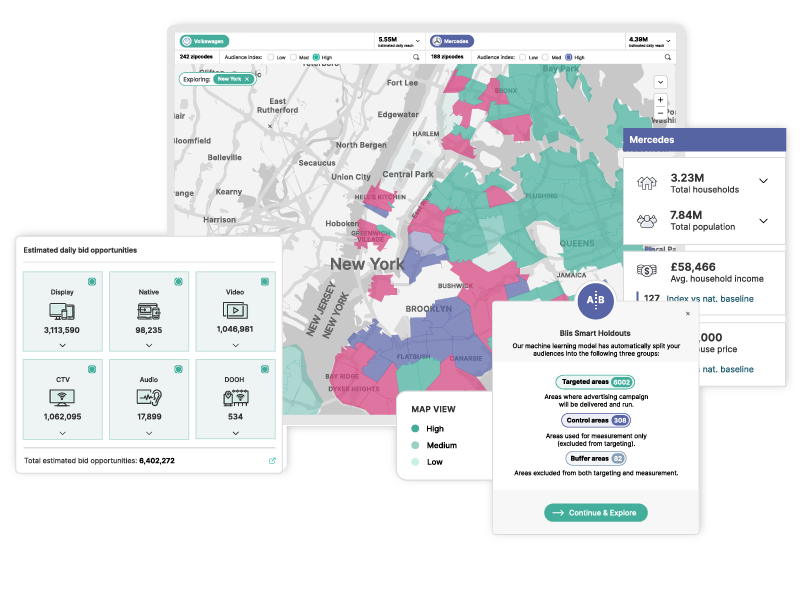
2024 will usher in some of the biggest changes to digital advertising since the launch of the iPhone. Third-party cookies – the technology that has dominated the ad industry for over two decades – will be fully deprecated this year.
The time for cookieless advertising solutions is now. But is the industry prepared?


Watch a recent webinar on the Great Privacy Disconnect, where Blis experts discuss the findings of our research, alternatives to identifier-based advertising and a closing window of opportunity for advertisers looking to get ahead.


Marketers are prepared for this momentous shift…aren’t they?


Half of US marketers don’t have a post-cookie plan, despite third-party cookies being scheduled for full deprecation by Google by Q3 2024.
That’s right. A recent Blis survey of US marketers found that 49% do not have a plan to replace third-party cookies. Among those without a plan, only 36% intend to implement a new solution by April 2024.
Such figures highlight an industry ill-prepared for this new era of cookieless advertising.
It’s thought that the loss of third-party cookies could cost advertisers up to $10 Billion in lost revenues per year. (Hallam)
Almost half (49%) of US marketers don't have a plan for cookieless advertising
Blis & Sapio, 2023


A closing window
The apparent lack of concern is surprising given that 75% of marketers still rely heavily on third-party cookies (Adobe). And that’s despite Google recently confirming that they aim to complete full deprecation of cookies on Chrome by Q3 this year.
Given such reliance, you’d be forgiven for thinking that the advertising industry would be more concerned.

Identifiers are already disappearing
Globally, 80% of iPhone users have already opted out of sharing their data. Plus, Safari, Firefox and Micorsoft Edge have already abandoned third-party cookies.
While marketers may still be achieving scale right now, in large part thanks to Chrome, half of mobile audiences and almost half of desktop audiences are already unreachable across the open internet.
98% of marketers say they’re concerned about signal loss and the disappearance of third-party cookies. (AdExchanger)
But concerned doesn’t mean prepared!


The Chrome Privacy Sandbox
As of 2023, roughly 63% of internet users relied on Google Chrome as their primary web browser.
Google has offered the Chrome Privacy Sandbox as a way to maintain advertising scale across Chrome.
However, with only months left before third-party cookies are fully deprecated on Chrome, over half of US marketers (61%) haven’t yet tested the Chrome Privacy Sandbox.
61% of US marketers are yet to test the Chrome Privacy Sandbox as a cookieless advertising solution
Blis & Sapio, 2023
Privacy Sandbox pros and cons
Pros
- Privacy-focused. Operates in a sandboxed environment, minimizing user data exposure.
- Supports various targeting options. Allows targeting based on interests, demographics and contextual signals.
- Future-proof. Google's market dominance suggests wider adoption and potential standardization.
Cons
- Limited adoption. Still in development / roll-out, with low publisher and user participation.
- Complex setup. Requires integration with Google's APIs and tools, demanding technical expertise and willingness to integrate further with Google.
- Limited measurement. Conversion tracking and campaign measurement are still under development. Cohorts change regularly, meaning no stable base for measurment.
- Strengthening tech giants. Handing market standardisation to Google further strengthens their market domninance and leaves the market vulnerable to its policies.

Other technologies rely on Unified IDs. But there are some major challenges to these approaches; primarily scalability and data reconciliation issues, plus consumers’ valid and sustained concerns with the use of their personal data.
Irreconcilable user data
A key drawback to UID2 is that the majority of consumers take steps to create boundaries between the different parts of their digital lives.
With most consumers having multiple ‘digital personas’, they are extremely unlikely to log-in to every site they access with only one, making reconciliation of anonymised IDs impossible.
Value exchange models aren’t new, and there have been many attempts in recent years to reward or otherwise compensate users for sharing their data. However, most rely on the user installing or using a third-party browser or app, and adoption has yet to become mainstream.
See: Gener8, Caden, Invisibly, Pogo, Tapestri
69% of US consumers find having to share their details to access content invasive, or just won't do it.
Blis & Sapio, 2023
A value exchange?
To work, Unified IDs rely on a value exchange: consumers share either their email address or telephone number with a publisher in exchange for accessing content.
But nearly a third of Americans (31%) are unwilling to give their email or phone number to access a publisher’s website.
An additional 38% may share their data but find being required to do so invasive.
Unified ID 2.0 pros and cons
Pros
- Closest direct replacement to the concept of a 'cookie'.
- Reach and identity. Offers a persistent, deterministic user ID across multiple publishers.
- Flexible targeting. Enables audience segmentation based on rich data sets and custom attributes.
- Existing infrastructure. Leverages existing ad tech infrastructure, simplifying adoption.
Cons
- Fragmented solutions still being built.
- Privacy concerns. Relies on an exhange of personal data, raising potential privacy issues.
- Data leakage risk. The deterministic nature of the ID increases the risk of data breaches.
- Limited scale. Reliant on a user's willingness to share personal ID & TheTradDesk's network, potentially restricting reach.


An opportunity to evolve?
Invasive. That sounds a lot like the criticism leveled at third-party cookies, doesn’t it?
Consumer pressure around privacy played an integral role in the ad industry’s recognition and resulting action against third-party cookies.
So, are Unified IDs simply missing the point? Should the deprecation of cookies be instead seen as an opportunity to move away from identifier-based technologies entirely?
Less than half (46%) of Americans know what internet cookies are. (All about cookies)



Privacy and data usage
The research around consumer privacy concerns is extensive and points towards one very clear fact; consumers don’t like their data being used by companies.
68%
81%
81% of users say the potential risks they face from companies collecting data outweigh the benefits. (Pew Research Center)
65%
Nearly two out of three Americans believe threats to their personal information are growing faster than businesses and organizations can keep up. (AU10TIX)
81%
81% of users believe the way a company treats their personal data is indicative of the way it views them as a customer. (Cisco)
63%
63% of Internet users believe most companies aren’t transparent about how their data is used, and 48% have stopped shopping with a company because of privacy concerns. (Tableau)
86%
86% of Americans believe businesses and organizations collect more information than needed. (AU10TIX)

Tailored but not invasive
Whilst it’s clear that consumers don’t like being tracked or identified across the web, that’s not to say they don’t recognise the value of personalized advertising.
Consumers want personalized ads but don’t want their privacy to be impacted. Marketers think consumers will share their data in exchange for access to content, but many won’t.
Over three-quarters of consumers (76%) said that receiving personalized communications was a key factor in prompting their consideration of a brand, and 78% said such content made them more likely to repurchase. (McKinsey)
Over half (53%) of consumers think it is important to see personalized ads that fit their preferences, taste and buying habits.
Blis & Sapio, 2023


The need for cookieless advertising solutions
So, how can advertisers reach consumers with meaningful, personalized ads in a cookieless, non-invasive, identifier-free way? Marketers who implement successful cookieless advertising solutions stand to make huge gains over competitors who flounder.
Alternative options
We’ve looked at the Privacy Sandbox and UID2, but there are a whole host of other new, ‘old’ and evolved solutions available for marketers to test. These range from more traditional contextual placements to AI-powered innovations, and everything in between.
So, what should marketers bear in mind when deciding which approaches to test and potentially adopt?
The alternatives to third-party are numerous and sifting through the noise will be a challenge for even the most savvy marketers. (MarTech)
Look to trusted industry bodies for guidance. (IAB Tech Lab event)



Important questions when considering new approaches
-
Is it omnichannel?
Can it be applied across all your unified media channels and audiences?
-
Does it evolve your advertising?
Will it help you seize the opportunity to move away from the identifier-centric past, or is it just cookies/identifiers in a new guise?
-
Does it work at scale?
Does the technology work at scale, allowing you to maintain reach whilst also personalizing to your audiences?


The solution: a game-changing, cookieless platform

Blis are world-leaders in cookie-free, omnichannel digital advertising. Since 2004 we have been helping our global brand partners navigate the bleeding edge of digital advertising innovation, and we believe 2024 presents an incredible opportunity for those brands looking to evolve their strategies and embrace cookieless advertising solutions.
We’re helping our partners succeed in this new, identifier-free era via our class-leading planning, buying and measurement platform: Blis Audience Explorer.

- A class-leading, intuitive, powerful platform built for omnichannel
- Detailed audiences, across any channel, without relying on cookies or IDs
- Measure like you plan with integrated omnichannel measurement tools
- Spend more of your money on media and less on fees


Get ahead in the cookieless advertising era
To find out how you can get ahead in the era of cookieless advertising and experience the power of Blis Audience Explorer, get in touch with our expert team now.


